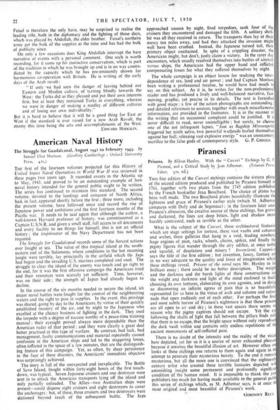American Naval History
THE first of the fourteen volumes projected for this History of United States Naval Operations in World War ll was reviewed in these pages two years ago. It recorded events in the Atlantic up to May, 1943, and proved to be an outstanding example of how naval history intended for the general public ought to be written. The series has continued to maintain this standard. The second volume, devoted to the landings and conquest of North Africa, had, in fact, appeared shortly before the first ; three more, including the present volume, have followed since and record the rise of Japanese power and ambitions and the first fourteen months of the Pacific war. It needs to be said again that although the author, a well-known Harvard professor of history, was commissioned as a Captain U.S.N.R. and given a small staff, full access to all documents and every facility to see things for himself, this is not an official history ; the imprimatur of the Navy Department has not been required. The Struggle for Guadalcanal records some of the fiercest actions ever fought at sea. The value of this tropical island at the south- eastern end of the Solomons, where conditions in the hot steaming jungle were terrible, lay principally in the airfield which the Japs had begun and the invading U.S. marines completed and used. The struggle to clear the island of the enemy was touch and go right to the end, for it was the first offensive campaign the Americans tried and their resources were scarcely yet sufficient. Time, however, was on their side ; the strength of Japan had already begun to decline.
In the course of the six months needed to secure the island, six major naval battles were fought for the control of the neighbouring waters and the right to pass in supplies. In the event, this privilege was shared, going by day to the Americans, by virtue of their quickly established mastery of the air, and by night to the Japanese who excelled at the chancy business of fighting in the dark. They used the torpedo with a degree of success worthy of a peace-time training manual ; their eyesight proved always more dependable than the American radar of that period ; and they were clearly a great deal better practised at this type of warfare. By contrast, bad luck, bad management, faulty communications and material repeatedly caused confusion in the American ships and led to the staggering losses, often inflicted in the space of a few minutes, that are the distinguish- ing feature of this campaign. Yet, as often, by sheer persistence in the face of these disasters, the Americans' immediate objective was surprisingly achieved.
The story is full of the unexpected and inexplicable. The Battle of Savo Island, fought within forty-eight hours of the first touch- down, was typical. Seven Japanese cruisers and one destroyer were sent in to attack the American transports lying off the island and only partially unloaded. The Allies—two Australian ships were present—could dispose eight cruisers and eight destroyers to cover the anchorages ; but, of these, three cruisers and two destroyers were stationed beyond reach of the subsequent battle. The Japs
approached unseen by night, fired torpedoes, sank four of the cruisers they encountered and damaged the fifth. A solitary shell. hit was all they received in return. The transports then lay at their mercy ten miles away, and had they attacked the invasion might well have been crushed. Instead, the Japanese turned tail, their primary object unattained. In spite of a crippling disaster, the Americans might, but don't, justly claim a victory. In the rarer day encounters, which usually resolved themselves into battles of aircraft versus ships, the Americans had the upper hand and inflicted compensating losses for what they suffered themselves by night.
The whole campaign is an object lesson for studying the inter. dependence of sea, land and air power ; and had Captain Morison been writing a professional treatise, he would have had much to say on this subject. As it is, he writes for the non-professional reader and has produced a lively and well-balanced narrative, fast. moving, graphic, yet precise in its details. The text is furnished with good maps ; a few of the action photographs are outstanding : and detailed references to sources, together with much miscellaneous information, are provided in the footnotes. It is in the manner of the writing that an occasional complaint could be justified. It is never difficult to read, never unintelligible ; but surely, to choose one of the not infrequent lapses, " Just as flagship Minneapolis triggered her ninth salvo, two powerful war, eads hurled themselves against her hull, releasing vast explosive energy " was an unnecessary sacrifice to the false gods of contemporary style. G. P. GRIGGS.






































 Previous page
Previous page